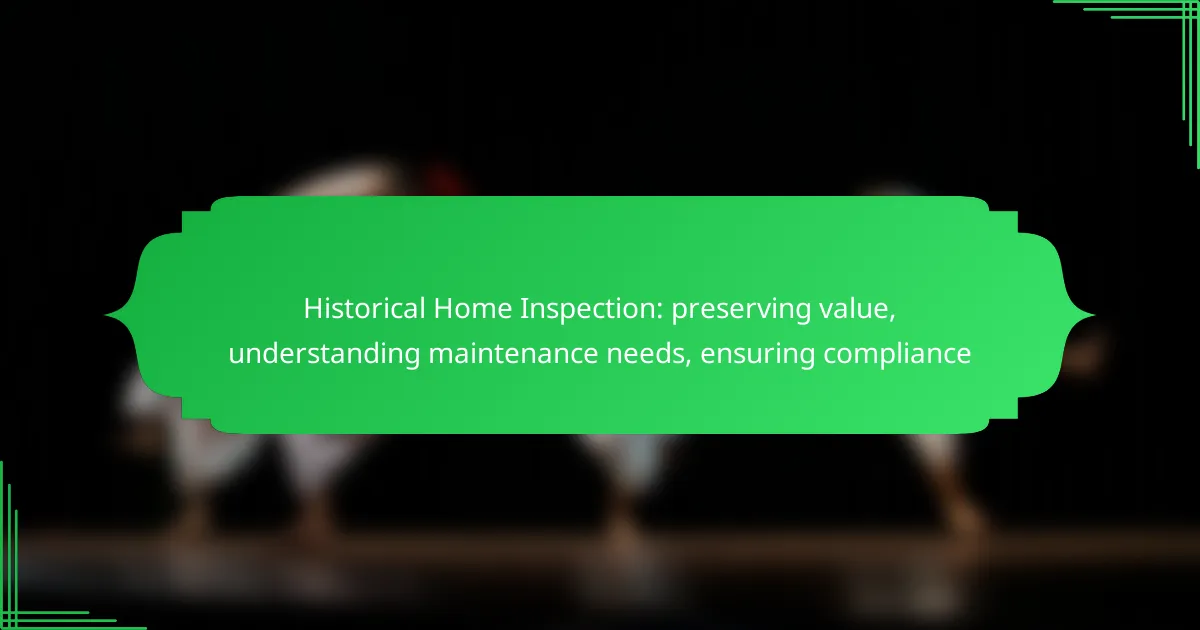Maintaining the value of a historical home requires diligent attention to preservation practices, including regular inspections and appropriate restoration techniques. By focusing on key maintenance areas and ensuring compliance with local regulations, homeowners can protect both the aesthetic and structural integrity of their properties. Understanding the nuances of historical preservation is essential for safeguarding these unique homes for future generations.

How to preserve historical home value in the United States?
Preserving the value of a historical home in the United States involves regular maintenance, appropriate restoration techniques, and the use of authentic materials. These practices not only enhance the home’s aesthetic appeal but also ensure compliance with preservation standards, which can protect property values over time.
Regular maintenance schedules
Establishing a regular maintenance schedule is crucial for preserving historical homes. This includes routine inspections of roofing, plumbing, and electrical systems, which should be conducted at least annually to identify any potential issues early.
Homeowners should also consider seasonal maintenance tasks, such as cleaning gutters in the fall and checking for water damage in the spring. Keeping a detailed log of maintenance activities can help track the home’s condition and inform future repairs.
Restoration techniques
When restoring a historical home, it’s essential to use techniques that respect the original architecture. This might involve repairing rather than replacing original features, such as windows and moldings, to maintain the home’s character.
Employing skilled craftsmen familiar with historical techniques can ensure that restorations are both authentic and durable. Homeowners should also research local preservation guidelines to comply with any regulations regarding restoration practices.
Using authentic materials
Using authentic materials is vital for maintaining the integrity of a historical home. This means sourcing period-appropriate materials that match the original construction, such as wood types, bricks, and roofing materials.
Homeowners should prioritize quality over cost when selecting materials, as using modern substitutes can diminish the home’s historical value. Consulting with preservation specialists can provide guidance on the best materials to use for repairs and restorations.

What are the common maintenance needs for historical homes?
Common maintenance needs for historical homes include regular inspections and repairs to preserve their structural integrity and aesthetic value. Homeowners should focus on key areas such as the roof, foundation, plumbing, and electrical systems to ensure compliance with local regulations and maintain safety.
Roof inspections and repairs
Roof inspections are crucial for historical homes due to their unique architectural features and materials. Homeowners should check for missing shingles, leaks, and signs of wear, ideally at least twice a year and after severe weather events.
When repairs are needed, consider using materials that match the original roofing to maintain historical accuracy. For example, if the roof is slate or cedar shake, sourcing similar materials can help preserve the home’s character while ensuring durability.
Foundation assessments
Foundation assessments are essential to identify any settling or structural issues that may arise over time. Look for cracks in walls, uneven floors, or doors that stick, as these can indicate foundation problems.
Regular monitoring and maintenance can prevent costly repairs. If issues are detected, consult a structural engineer experienced with historical properties to determine the best course of action, which may include underpinning or drainage improvements.
Plumbing and electrical updates
Updating plumbing and electrical systems in historical homes is vital for safety and efficiency. Many older homes have outdated systems that do not meet current codes, posing risks such as leaks or electrical fires.
Consider hiring professionals who specialize in historical renovations to ensure that updates are done sensitively and in compliance with local regulations. This may involve using modern materials that blend seamlessly with the home’s original design while enhancing functionality.

How to ensure compliance with historical preservation regulations?
Ensuring compliance with historical preservation regulations involves understanding local laws, obtaining necessary permits, and consulting with experts in the field. These steps help maintain the integrity of historical properties while adhering to legal requirements.
Understanding local preservation laws
Local preservation laws vary significantly by region and can dictate what modifications are permissible on historical properties. Familiarize yourself with the specific regulations in your area, which may include zoning laws, architectural guidelines, and restrictions on materials used in renovations.
Many municipalities have a preservation board or commission that oversees compliance. Engaging with these entities can provide clarity on what is required and help avoid costly mistakes.
Obtaining necessary permits
Before starting any work on a historical property, it is crucial to obtain the appropriate permits. This may include building permits, demolition permits, or special permits for alterations that affect the historical character of the property.
Check with your local government office to understand the specific permits required. Typically, the process involves submitting detailed plans and possibly undergoing a review period, which can take several weeks to months.
Consulting with preservation experts
Consulting with preservation experts can provide invaluable insights into maintaining compliance with historical regulations. These professionals can offer guidance on best practices for restoration and renovation, ensuring that any work done aligns with preservation standards.
Consider hiring an architect or contractor who specializes in historical properties. Their expertise can help navigate the complexities of preservation laws and avoid common pitfalls, ultimately protecting the property’s value and historical significance.

What are the benefits of a historical home inspection?
A historical home inspection provides crucial insights into a property’s condition, maintenance needs, and compliance with regulations. This process helps homeowners understand the unique challenges of maintaining older structures while preserving their value.
Identifying hidden issues
Historical homes often have concealed problems that may not be immediately visible. An inspection can uncover issues such as outdated electrical systems, plumbing leaks, or structural weaknesses that could lead to costly repairs if left unaddressed.
Inspectors typically look for signs of deterioration, such as water damage, mold, or pest infestations. Addressing these hidden issues early can prevent more extensive damage and preserve the home’s integrity.
Enhancing property value
A thorough inspection can significantly enhance a historical home’s value by ensuring it is well-maintained and compliant with local regulations. Buyers are often willing to pay a premium for properties that have been properly inspected and maintained.
Investing in repairs and upgrades identified during the inspection can yield a strong return on investment, particularly in markets where historical homes are in high demand. Documenting the inspection findings can also serve as a valuable selling point when listing the property.
Improving safety standards
Safety is a primary concern in any home, but historical properties may have outdated features that do not meet current safety standards. An inspection can highlight necessary upgrades, such as installing modern smoke detectors, carbon monoxide detectors, and secure railings.
By addressing safety concerns, homeowners not only protect their investment but also ensure a safe living environment for occupants. Compliance with local building codes and safety regulations can also prevent potential legal issues down the line.

What factors influence historical home inspection costs?
Historical home inspection costs are influenced by various factors, including the size and condition of the home, its location and market demand, and the scope and detail of the inspection itself. Understanding these elements can help homeowners budget appropriately and ensure they receive a thorough evaluation.
Home size and condition
The size of a historical home significantly impacts inspection costs. Larger homes typically require more time and resources to inspect, leading to higher fees. Additionally, the condition of the home plays a crucial role; homes in poor condition may require more detailed inspections, increasing costs further.
For example, a small, well-maintained historical home may cost less than a large, dilapidated one. Homeowners should consider the potential for additional costs if significant repairs or issues are discovered during the inspection.
Location and market demand
Location affects inspection costs due to varying market demands and regional pricing standards. In urban areas with high demand for historical properties, inspection fees may be elevated compared to rural locations. Local regulations and the availability of qualified inspectors can also influence pricing.
For instance, a historical home in a sought-after neighborhood may incur higher inspection costs than one in a less desirable area. Homeowners should research local inspection rates to gauge what to expect based on their specific location.
Inspection scope and detail
The scope and detail of the inspection directly impact costs. A standard inspection may cover essential structural and safety elements, while a comprehensive evaluation might include specialized assessments of historical features, systems, and compliance with preservation standards. More detailed inspections naturally come with higher fees.
Homeowners should clarify the inspection scope with their inspector beforehand. Understanding what is included can help avoid unexpected costs and ensure that all necessary aspects of the historical home are thoroughly evaluated.

How to choose a qualified historical home inspector?
Choosing a qualified historical home inspector involves verifying their credentials, experience, and client feedback. A thorough selection process ensures that the inspector understands the unique needs of historical properties and can provide accurate assessments.
Checking certifications and experience
Start by confirming that the inspector holds relevant certifications, such as those from the American Society of Home Inspectors (ASHI) or the National Association of Certified Home Inspectors (NACHI). Experience with historical homes is crucial, as these properties often have unique structural and material characteristics.
Look for inspectors who have completed specialized training in historical preservation or restoration. A qualified inspector should have several years of experience, ideally with a portfolio showcasing past inspections of similar properties.
Reading client reviews
Client reviews provide insight into the inspector’s reliability and thoroughness. Check online platforms like Google, Yelp, or specialized real estate websites for feedback from previous clients.
Pay attention to comments regarding the inspector’s communication skills, attention to detail, and ability to explain findings clearly. A pattern of positive reviews can indicate a trustworthy inspector, while consistent negative feedback may be a red flag.
Comparing inspection services
When comparing inspection services, consider the scope of the inspection offered. Some inspectors may provide a basic assessment, while others include detailed reports on structural integrity, compliance with local regulations, and recommendations for maintenance.
Request quotes from multiple inspectors to understand pricing structures. Typical inspection costs can vary widely, often ranging from a few hundred to over a thousand dollars, depending on the property’s size and complexity. Ensure that the services included in the price align with your needs for a historical home.
